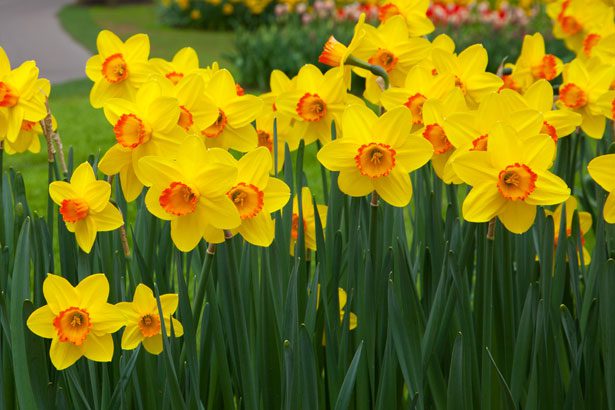
Planting Spring Flowering Bulbs
Spring is a season of rebirth and rejuvenation, and what better way to celebrate it than by planting a garden full of vibrant, colourful bulbs? But when is the right time to plant spring bulbs? And how do you ensure they bloom beautifully when the season comes? In this comprehensive guide, we’ll answer all your questions and share expert advice on how to plant spring bulbs successfully.
Understanding Spring Bulbs
Before we delve into the timing and techniques of planting, it’s essential to understand what spring bulbs are. Spring bulbs are a group of flowering plants that grow from bulbous structures stored underground. They are often the first plants to bloom in spring, adding a splash of colour to gardens after the long winter months.
Key Spring Bulbs to Plant
Here are some of the most popular spring bulbs to consider for your garden:
1. Tulips: Known for their vibrant colours and elegant shape, tulips are a classic choice for any spring garden.
2. Daffodils: These cheerful yellow flowers are often associated with the arrival of spring.
3. Hyacinths: With their sweet fragrance and densely packed flowers, hyacinths are a delight for the senses.
4. Alliums: These plants produce striking spherical blooms that can add a touch of drama to your garden.
5. Crocus: Among the earliest bloomers, crocus flowers can add colour to your garden starting in early Spring.
6. Snowdrops: Usually the first plants to flower, snowdrops flowers are a sign that spring is truly on its way.
When to Plant Spring Bulbs
Timing is crucial when planting spring bulbs. Plant too early, and the bulbs might rot in the damp soil. Plant too late, and they might not have enough time to establish before the ground freezes.
Ideal Planting Time
The best time to plant spring bulbs is in the autumn, around six weeks before the first hard frost is expected. This gives the bulbs a chance to establish roots before winter sets in. In most regions, this means planting in late September to October.
However, the exact timing can vary depending on your local climate and the specific bulbs you are planting. For instance, tulips and daffodils are typically planted earlier than crocuses and hyacinths.
Preparing for Planting
Before you start planting, there are a few preparatory steps you should take to ensure the success of your spring bulbs.
Choose Healthy Bulbs
Start by selecting healthy bulbs from a reliable supplier. Look for bulbs that are firm to the touch, with no signs of mould, rot, or damage. The larger the bulb, the more likely it is to produce a healthy, vigorous plant.
Prepare the Soil
Next, prepare the soil by removing any weeds or stones and breaking up large clods of soil. Most spring bulbs prefer well-drained soil, so consider adding some grit or sand to heavy clay soils to improve drainage. You can also purchase a premixed bulb potting mix which can be used for planting bulbs inside or outside.
Plan Your Design
Think about where and how you want to plant your bulbs. Spring bulbs can be planted in borders, containers, or naturalised in lawns or woodland areas. Consider the height and colour of the plants when in bloom to create a pleasing design.
Planting Spring Bulbs
Once you’ve prepared your bulbs and the planting site, it’s time to get planting.
Planting Depth and Spacing
As a general rule, bulbs should be planted at a depth three times their height and spaced two to three times their width apart. However, always check the planting instructions specific to the type of bulb you are planting.
Planting Technique
To plant the bulbs, dig a hole to the correct depth, place the bulb in the hole with the pointy end facing up, and then backfill with soil, firming it gently around the bulb. A bulb planting tool can help with this.
Aftercare
Once planted, water the bulbs well to help them establish. Throughout the winter, keep the soil moderately moist but avoid waterlogging, which can cause bulbs to rot.
Caring for Spring Bulbs After Flowering
After your bulbs have bloomed in the spring, it’s important to care for them properly to ensure they return the following year.
Deadheading
Once the flowers have faded, you can remove them to prevent the plant from wasting energy on seed production. However, leave the foliage intact until it has died back naturally.
Feeding
After flowering, feed the bulbs with a high-potassium fertiliser to help them store energy for the next year’s bloom.
Common Problems and Solutions
Like all plants, spring bulbs can encounter some problems. Here’s how to deal with the most common ones:
Bulbs Not Flowering
If your bulbs are not flowering, it could be due to several reasons, including insufficient light, overcrowding, or a lack of nutrients. Consider moving the bulbs to a sunnier location, dividing overcrowded clumps, or feeding with a bulb fertiliser.
Pests and Diseases
Bulbs can be affected by pests such as squirrels, voles, or slugs, and diseases such as rot or mould. To prevent these problems, plant bulbs deeply, use pest deterrents and ensure good drainage.
Final Thoughts
Planting spring bulbs is a rewarding gardening task that promises a beautiful display of blooms come spring. By choosing the right time to plant, preparing the soil and bulbs adequately, and providing appropriate aftercare, you can look forward to a garden full of colour year after year.
Remember, the key to successful bulb planting is planning ahead. So, when autumn comes, it’s time to roll up your sleeves and start planting those spring bulbs. Your efforts will be rewarded with a stunning spring display that heralds the arrival of warmer days and new beginnings. Happy planting!



